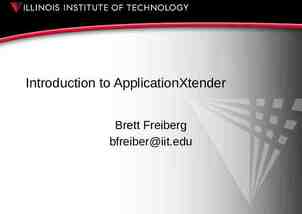A Strategic Opportunity for Texas A&M-Corpus Christi and Texas
26 Slides2.23 MB
A Strategic Opportunity for Texas A&M-Corpus Christi and Texas A&M-Kingsville November 10, 2016
Historical Perspective University System of South Texas (1977-1989) – Upper-level campuses in Corpus Christi and Laredo – Flagship/headquarters in Kingsville USST officials recognized the need to unify – Efforts were made to add schools & strengthen USST’s presence in the Coastal Bend – Officials saw Pan American College and others as future competition Since joining the Texas A&M University System in 1989, all three USST schools have flourished 2
Why Consider Consolidation? Two Campuses, One Mission 3
Why Could Consolidation Make Sense? One large university to serve South Texas The most university research activity south of San Antonio Texas A&M University System’s first “emerging research university” Increased opportunities for students and faculty Cost savings over time A wealth of natural resources on land, at sea, and in the air 4
Is the Time Right? The issue hinges on local and System interest, and there are reasons for that interest now . . . Presidential vacancy at TAMUCC provides opportunity Legislative climate requires efficiencies Coastal Bend Region primed for economic development Competition is increasing from UT-RGV, Texas State University, UT-San Antonio, Texas A&M-San Antonio Timing is crucial to get ahead of competitors – Enrollment – Student Success – Research 5
Academic Competition in South Texas Texas State UH UT-San Antonio A&M-San Antonio UT-Rio Grande Valley 6
Enrollment & Demographics Fall 2016 Preliminary 20th Class Day Enrollment TAMUK TAMUCC COMBINED 9,290 12,174 21,464 14% 38% 28% 5% 6% 5% 60% 46% 52% Asian 1% 3% 2% American Indian/Alaskan Native 0% 0% 0% 19% 4% 10% Not Reported 0% 2% 1% Native Hawaiian/Pacific Islander 0% 0% 0% Multiracial 0% 2% 1% White/Non-Hispanic African American Hispanic Non-Resident Aliens/Foreign Nat’ls 7
Metrics Degrees Awarded* Fiscal Year 2015 TAMUK TAMUCC Total Degrees Awarded COMBINED 1,903 1,997 3,900 Undergraduate 937 1,461 2,398 Masters 945 512 1,457 Doctoral 21 24 45 Research Expenditures** Fiscal Year 2015 Total Research Expenditures Restricted Research Expenditures TAMUK TAMUCC 19,052,550 COMBINED 23,206,229 12,723,245 14,693,004 42,258,779 27,416,249 Endowments Fiscal Year 2015 System Endowment Fund Affiliated Foundations Endowment Fund TAMUK TAMUCC 20,728,327 62,189,013 COMBINED 14,357,846 83,270,301 35,086,173 145,459,314 Data Sources: * THECB Prep Online ** THECB Accountability System 8
Among Public Universities in Texas A&M-Corpus Christi A&M-Kingsville Combined Total Enrollment 19th 21st 12th Hispanic Enrollment 14th 13th 7th Degrees Awarded 20th 23rd 13th Data source: THECB Accountability System, FY 2015 9
State Funds for “Emerging Research” Texas Research Incentive Program (TRIP) – Current biennium funding: 138,097,074 – Eligible institutions: Emerging research universities Core Research Support Fund (CRS) – Current biennium funding: 117,111,410 – Eligible institutions: Emerging research universities National Research University Fund (NRUF) – Current biennium funding: 37,817,288 – Eligible institutions: Emerging research universities that have expenditures of at least 45 million in restricted research and meet other criteria 10
Current Emerging Research Universities Texas Tech UNT UT-Dallas UT-Arlington UT-El Paso Texas State UT-San Antonio UH ? 11
To Qualify for “Emerging Research” Emerging Research Universities are expected to meet the following criteria for two consecutive years – Offer a comprehensive range of excellent undergraduate and graduate programs – Award at least 30 PhD degrees annually – Generate at least 20% of the research universities’ criteria for restricted research expenditures (20% of 150 million, adjusted for inflation) 12
Comprehensive Range of Programs Texas A&M UniversityCorpus Christi Academic College (Departmental Accreditation) Texas A&M UniversityKingsville # of Programs Bachelors-7 Masters-3 Bachelors-3 Masters-10 College of Education and Ed.D--1 Human Development (CACREP) Ph.D.--2 College of Business (AACSB) College of Liberal Arts (NASM) Nursing and Health Sciences (CCNE) College of Science and Engineering (ABET) N/A N/A TOTAL Academic College (Departmental Accreditation) # of Programs College of Business Administration Bachelors-6 (ACBSP) Masters-1 College of Education and Human Performance Bachelors-25 College of Arts and Sciences Masters-6 (NASM) Bachelors-2 Masters-3 Ph.D.-1 DNP-1 N/A Bachelors-13 Masters-7 Ph.D.-3 College of Engineering (ABET) College of Agriculture, Human 0 Sciences, and Natural Resources 0 Honors College Bachelors-50 Masters-29 Ed.D.-1 Ph.D.-6 DNP-1 Total Bachelors-2 Masters-10 Ed.D.-1 Bachelors-24 Masters-12 Ph.D.-1 0 Bachelors-9 Masters-9 Ph.D.-2 Bachelors-7 Masters-6 Ph.D.-2 Bachelors-48 Masters-38 Ed.D.-1 Ph.D.-5 13
PhDs & Restricted Research Institution Restricted Research Expenditures* PhD Award Count** University of Houston 64,394,171 236 Texas Tech University 48,774,414 283 UT-Dallas 45,111,033 178 UT-El Paso 46,821,190 108 UT-Arlington 31,614,826 219 30,000,000 30 TAMUCC & TAMUK 27,416,249 22 UT-San Antonio 25,026,676 92 Texas State University 27,244,557 42 University of North Texas 16,097,336 227 Emerging Research Criteria *Texas Higher Education Coordinating Board, FY 2015 ** Texas Higher Education Coordinating Board, FY 2014 14
Advantages for Students Access to broader, more diverse programs of study for all students—increased access to academic courses and majors. Potential administrative cost savings that could be channeled into education and research. Access to grants & student activities at both campuses will support and engage students. 15
Advantages for Teaching and Research Access to laboratory equipment and lab space at both campus Access to classroom technology and distance learning at both campuses Greater ability to recruit professionals to the region Provides a fast path to Emerging Research Institution designation and additional research funding (matching or formula) 16
Advantages for South Texas Stronger competitiveness in the expanded higher education market against larger, emerging research universities Enhanced image—making it easier to recruit and retain top scholars and professors Enhanced economic development: Leading the way in work force development, public service & local spending. In FY13, the two campuses combined produced 751 million in economic benefits to the Coastal Bend region.* This will be increase with unification and Emerging Research Institution funding. *EMSI Study Commissioned by CPUPC 17
Challenges Blending of two campus cultures/identities. It takes time to build trust and to identify with a new brand. Short-term costs (advertising, signage, technology, etc.) Resolving and combining administrative functions. Decisions about athletic programs. Providing an enhanced educational mix at both campuses. 18
Concerns How to address local concerns about future direction of the University How to engage and encourage alumni support How to establish a process to communicate effectively with faculty, staff and students and solicit their input How to resolve back office issues involving financial operations, student records, fund raising and other issues Branding issues How to build on and enhance the University’s identity over time 19
Other Considerations & Questions Academics How would academic programs be allocated between sites to successfully reflect a two-campus/one-university approach? How would program offerings be consolidated and distributed to meet student needs? How would consolidation affect any current academic programs? How would consolidation affect any current research activity? How would consolidation be used to benefit in faculty recruitment? Athletics How will athletic programs be coordinated? Would changes in conference affiliation affect any sport? Would construction of new facilities be required? 20
Athletics TAMUCC is in the Southland Conference, NCAA Division I Men: Baseball, Basketball, Cross Country, Track & Field, Tennis Women: Basketball, Beach Volleyball, Cross Country, Golf, Soccer, Softball, Tennis, Track & Field, Volleyball TAMUK is in the Lone Star Conference, NCAA Division II Men: Baseball, Basketball, Cross Country, Track & Field, Football Women: Basketball, Beach Volleyball, Cross Country, Golf, Softball, Tennis, Track & Field, Volleyball 21
Communication Would Be First Priority Forums to explain the idea and allay concerns will be necessary Will require input & acceptance from: – Public – Faculty – Current Students – Alumni 22
Necessary Steps for Legislation If the Board approved consolidation, it would be a 3-5 year process requiring legislative approval . . . Texas A&M University System Board of Regents approval Submission of higher education impact statement by THECB to Legislative Budget Board, laying out pros, cons, and estimated costs Passage of Senate or House Bill 23
Necessary Steps with SACSCOC Southern Association of Colleges and Schools Commission on Colleges approval is necessary for regional accreditation. CEOs must provide written notice of the change 6 months in advance of date of review of the change by SACSCOC Board. Review and approval process requires a minimum of 2-3 years before accreditation is granted. 24
Other Accreditations Both institutions will need to research the requirements and implications for specific program accreditations: – ABET (Engineering) – AACSB (Business) – NASM (Music) – CACREP (Counseling) – CCNE (Nursing) – Other 25
Questions? 26































